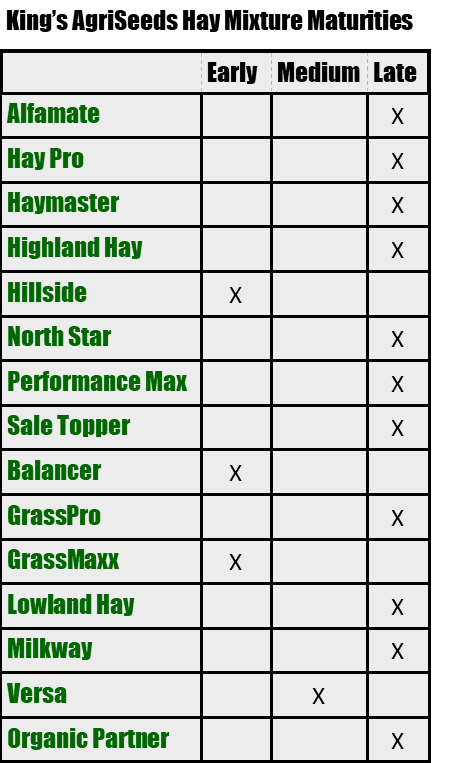By Joy Beam – King’s AgriSeeds, New Jersey Regional Coordinator
Have you ever considered the depth of your hay fields portfolio? Just as diversity in business helps limit risk, diversifying your hay fields helps you weather the all-too-familiar challenges that come with making hay. With many different forage species available, hay programs can easily be diversified by strategically taking advantage of differing maturities of various species.
By incorporating early and later maturities onto your acres, the harvest window can be widened as early maturing fields can be harvested with ample time before later maturing fields are ready to harvest. On operations with many acres to cut, this can be vital in maximizing both the quality and quantity of hay produced. Similarly, if rain keeps one maturity group from being cut at peak time, it is more than likely that the other maturity class will have better weather when it is ready to be harvested. Below is a summary of maturity patterns for straight common hay cultivars to aid in developing your hay portfolio:
Orchardgrass: Early, medium, and late maturing orchardgrasses are available on the market with up to two weeks’ difference between early and late maturity dates. Late maturing orchardgrasses pair well with alfalfa. Some southern producers prefer early maturing orchardgrasses as they can put on most of their first cutting growth and replenish resources before it gets hot.
Tall Fescue: As a whole, tall fescue matures later than orchardgrass. However, later maturing varieties such as Kora and STF 43 still pair well with late heading orchardgrasses.
Timothy: There is a wide difference in maturity dates between early and late timothies. Early timothy varieties, like Zenyatta, can be paired with alfalfa or late orchardgrasses while late varieties will mature after fescue.
Smooth Brome: Smooth brome matures very late. Even if harvested after the ideal date, brome grass holds its quality better compared to other hay varieties. Since it is advised to let it go to seed once per year and is similar to timothy in that most of its production comes in the spring, smooth brome can be paired with timothy if limited management later in the year is desired.

Incorporating different maturities will diversify your hay business across fields, but diversifying your stands within fields is also recommended. A good way to do this is planting mixes of grass s
pecies. Depending on weather patterns, one variety may excel one year while another grass species will shine another year. This will also help combat against varying soil types within one field. King’s AgriSeeds has designed multiple mixes with this concept in mind that include species of similar maturity to diversify your business.
In some cases though, such as in the Sale Topper, GrassPro, Lowland Hay, Organic Partner, and Versa mixtures, a very small percentage of an earlier maturing variety is incorporated into the mix. This is called an ‘indicator’ specie. This will head out shortly before the other species of the mix, letting you know that it is time to cut the stand at the next given opportunity. Sure, you may lose quality on that small portion, but this allows you to capitalize in both quality and quantity on the larger portion of the mix. Regardless of if you plant a straight variety or a mix, use different maturity hay species to your advantage to strengthen the resilience of your hay operation.
Speak to an expert at King’s AgriSeeds now at 1-717-687-6224 or email us at [email protected].

Recent Comments